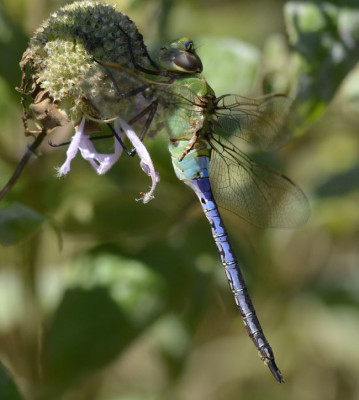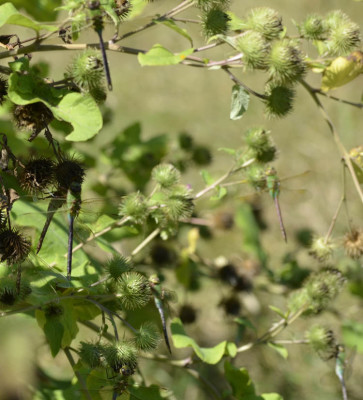The Snowbirds were not the only precision flyers patrolling the skies in and around Toronto at the end of this summer. Literally hundreds of large dragonflies were also on the wing over the school yards and meadows in Toronto and Mississauga. Unlike the more everyday small dragonflies, these ones have bodies almost as large as an index finger. Some children at two schools reported to me they felt a bit intimidated by the numbers and size of the insects.
Anax junius, Male Green Darner
What are These Large Green and Blue Dragonflies that Criss Cross the Sky?
Some dragonflies spend much of their time perched. These large blue and green ones, though, are on the wing most of the day. As with most dragonflies, the colours and markings of the males and females differ.
The gathering of large groups of these dragons is a clue to what kind they are. They are forming squadrons because they are heading south on migration, just like the Monarchs and Red Admiral butterflies that we hear more about.
Green Darner on Aster
Green Darners Move to the Sunny South in Search of Insects
Each fall, Green Darners gather along the shores of Lake Ontario on their way south to better winter hunting grounds. Each spring, they are some of the first dragonflies to re-appear as they migrate north on the warm spring winds.
In “Simple rules guide dragonfly migration” a group of scientists actually radio-tagged over a dozen Green Darners and followed them with a Cessna! They discovered that a combination of low wind speeds and cool night temperatures triggered the onward southerly movement of the Darners. The study states that like songbirds, migrating dragonflies often build up in numbers along the shores of the Great Lakes prior to crossing.
Female Green Darner
Migration Brings Its Own Dangers for Dragonflies
The Simple Rules study states that Kestrels are one of the main predators attacking Green Darners. I’ll have to keep my eyes open in future to see if I can spot one of these tiny feisty falcons feeding!
Flying out over open water is also risky for any small organism. If they tire there may be nowhere to rest. During the Simple Rules study, they found their beaconed dragonflies would first try to cross Delaware Bay at a wide point, but quickly retreated back to land and followed the shoreline until they reached a narrower crossing.
How many Green Darners can you count? Hint: Look for the “tails.” (There’s at least 7.)
While I have no evidence to prove it, I suspect Green Darners also follow the shore of Lake Ontario until they reach some of the narrow points before crossing. That would lead to the high densities seen at the narrow ends of the Lake near Toronto and Kingston.
According to the Fairfax County Public Schools website, and the Washington Post, Green Darners only live to migrate in one direction. Their offspring will make the return trip in the spring. (And their grandchildren will make the next trip south in the fall.) The strongest evidence of this is the lack of damage to the wings on the migrants travelling in either direction. (Unlike birds which can grow new feathers, dragonflies have no way to replace broken bits of wing.)
Not All Green Darners Migrate
Just like some Canada Geese migrate and others hang around all year, not all Green Darners migrate. While adult dragonflies cannot survive freezing temperatures, the nymphs which live submerged in the water of ponds and lakes can and do survive. They will emerge as adults when they are mature and the land surrounding the lake is warm enough.
Related Reading
Join In
Have you ever seen a swarm of hundreds of Green Darners on the wing? Did it feel just slightly uncomfortable walking underneath them? Please share your experiences with a comment.




